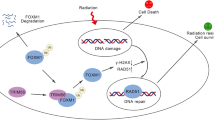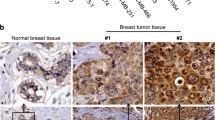Abstract
NRP1 is a transmembrane glycoprotein that is highly expressed in a variety of tumors. There is evidence that NRP1 can enhance the stem cell properties of tumor cells, which are thought to be resistant to radiotherapy. This study aims to elucidate the potential mechanism of NRP1 in radiation resistance. We transfected NRP1 siRNA and plasmid in breast cancer cells to detect the expression of cancer stem cell markers by western blot and qRT-PCR. The effect of NRP1 on radiotherapy resistance was assesses by immunofluorescence and flow cytometry. In vivo, we established xenograft tumor model treating with shRNA-NRP1 to assess radiotherapy sensitivity. We found that NRP1 could enhance the stem cell properties and confer radioresistance of breast cancer cells. Mechanistically, we proved that NRP1 reduced IR-induced apoptosis by downregulation of Bcl-2 via methyltransferase WTAP in m6A-depentent way. It is suggested that these molecules may be the therapeutic targets for improving the efficacy of radiotherapy for breast cancer.







Similar content being viewed by others
Date availability
The data and materials in the current study are available from the corresponding author on reasonable request.
Abbreviations
- BC:
-
Breast cancer
- NRP1:
-
Neuropilin-1
- CSCs:
-
Cancer stem cells
- BCSCs:
-
Breast cancer stem cells
- WTAP:
-
Wilms tumoe1-associated protein
- IHC:
-
Immunohistochemistry
- FS:
-
Field size
- SSD:
-
Source-surfaced distance
- IP:
-
Immunoprecipitation
- OS:
-
Overall survival
- DFS:
-
Disease-free survival
- dsDNA:
-
Double-stand DNA
- MeRIP:
-
Methylated RNA immunoprecipitation
- Bcl-2:
-
B-cell lymphoma 2
- DEPC:
-
Diethyl pyrocarbonate
- EG00229:
-
Neuropilin 1 (NRP1) receptor antagonist
- ER:
-
Estrogen receptor
- EDTA:
-
Ethylene diamine tetraacetic acid
- H&E:
-
Hematozlin and eosin stain
- IR:
-
Ionizing radiation
- m6A:
-
N6-methyladenosine
- PMSF:
-
Phenylmethanesulfonyl fluoride
- RTK:
-
Receptor tyrosine kinase
References
Sung H, Ferlay J, Siegel RL, Laversanne M, Soerjomataram I, Jemal A et al (2021) Global cancer statistics 2020: GLOBOCAN estimates of incidence and mortality Worldwide for 36 cancers in 185 Countries. CA Cancer J Clin 71:209–249
Speers C, Zhao S, Liu M, Bartelink H, Pierce LJ, Feng FY (2015) Development and validation of a novel radiosensitivity signature in Human breast cancer. Clin Cancer Res 21:3667–3677
Ebctcg MP, Taylor C, Correa C, Cutter D, Duane F et al (2014) Effect of radiotherapy after mastectomy and axillary surgery on 10-year recurrence and 20-year breast cancer mortality: meta-analysis of individual patient data for 8135 women in 22 randomised trials. Lancet 383:2127–2135
He Z, Tessier-Lavigne M (1997) Neuropilin is a receptor for the axonal chemorepellent semaphorin III. Cell 90:739–751
Kolodkin AL, Levengood DV, Rowe EG, Tai YT, Giger RJ, Ginty DD (1997) Neuropilin is a semaphorin III receptor. Cell 90:753–762
Douyere M, Chastagner P, Boura C (2021) Neuropilin-1: a key protein to consider in the progression of pediatric brain tumors. Front Oncol 11:665634
Rachner TD, Kasimir-Bauer S, Goebel A, Erdmann K, Hoffmann O, Rauner M et al (2021) Soluble Neuropilin-1 is an independent marker of poor prognosis in early breast cancer. J Cancer Res Clin Oncol 147:2233–2238
Clarke MF, Dick JE, Dirks PB, Eaves CJ, Jamieson CH, Jones DL et al (2006) Cancer stem cells–perspectives on current status and future directions: AACR workshop on cancer stem cells. Cancer Res 66:9339–9344
Nunes T, Hamdan D, Leboeuf C, El Bouchtaoui M, Gapihan G, Nguyen TT et al (2018) Targeting cancer stem cells to overcome chemoresistance. Int J Mol Sci 19:4036
da Silva-Diz V, Lorenzo-Sanz L, Bernat-Peguera A, Lopez-Cerda M, Munoz P (2018) Cancer cell plasticity: impact on tumor progression and therapy response. Semin Cancer Biol 53:48–58
Goel HL, Pursell B, Chang C, Shaw LM, Mao J, Simin K et al (2013) GLI1 regulates a novel Neuropilin-2/alpha6beta1 integrin based autocrine pathway that contributes to breast cancer initiation. EMBO Mol Med 5:488–508
Beck B, Driessens G, Goossens S, Youssef KK, Kuchnio A, Caauwe A et al (2011) A vascular niche and a VEGF-Nrp1 loop regulate the initiation and stemness of skin tumours. Nature 478:399–403
Hamerlik P, Lathia JD, Rasmussen R, Wu Q, Bartkova J, Lee M et al (2012) Autocrine VEGF-VEGFR2-Neuropilin-1 signaling promotes glioma stem-like cell viability and tumor growth. J Exp Med 209:507–520
Peng K, Bai Y, Zhu Q, Hu B, Xu Y (2019) Targeting VEGF-Neuropilin interactions: a promising antitumor strategy. Drug Discov Today 24:656–664
Huang W, Chen TQ, Fang K, Zeng ZC, Ye H, Chen YQ (2021) N6-methyladenosine methyltransferases: functions, regulation, and clinical potential. J Hematol Oncol 14:117
Wang X, Ma R, Zhang X, Cui L, Ding Y, Shi W et al (2021) Crosstalk between N6-methyladenosine modification and circular RNAs: current understanding and future directions. Mol Cancer 20:121
Xie W, Wei L, Guo J, Guo H, Song X, Sheng X (2019) Physiological functions of Wilms’ tumor 1-associating protein and its role in tumourigenesis. J Cell Biochem. https://doi.org/10.1002/jcb.28402
Sorci M, Ianniello Z, Cruciani S, Larivera S, Ginistrelli LC, Capuano E et al (2018) METTL3 regulates WTAP protein homeostasis. Cell Death Dis 9:796
Mercurio AM (2019) VEGF/Neuropilin signaling in cancer stem cells. Int J Mol Sci 20:490
Jarvis A, Allerston CK, Jia H, Herzog B, Garza-Garcia A, Winfield N et al (2010) Small molecule inhibitors of the Neuropilin-1 vascular endothelial growth factor A (VEGF-A) interaction. J Med Chem 53:2215–2226
Liu L, Zhang Z, Zhou L, Hu L, Yin C, Qing D et al (2020) Cancer associated fibroblasts-derived exosomes contribute to radioresistance through promoting colorectal cancer stem cells phenotype. Exp Cell Res 391:111956
Sun X, He Z, Guo L, Wang C, Lin C, Ye L et al (2021) ALG3 contributes to stemness and radioresistance through regulating glycosylation of TGF-beta receptor II in breast cancer. J Exp Clin Cancer Res 40:149
Siegel RL, Miller KD, Fuchs HE, Jemal A (2022) Cancer statistics, 2022. CA Cancer J Clin 72:7–33
Grun D, Adhikary G, Eckert RL (2018) NRP-1 interacts with GIPC1 and alpha6/beta4-integrins to increase YAP1/Np63alpha-dependent epidermal cancer stem cell survival. Oncogene 37:4711–4722
Wu L, Wu D, Ning J, Liu W, Zhang D (2019) Changes of N6-methyladenosine modulators promote breast cancer progression. BMC Cancer 19:326
Liu Z, Wu K, Gu S, Wang W, Xie S, Lu T et al (2021) A methyltransferase-like 14/miR-99a-5p/tribble 2 positive feedback circuit promotes cancer stem cell persistence and radioresistance via histone deacetylase 2-mediated epigenetic modulation in esophageal squamous cell carcinoma. Clin Transl Med 11:e545
Zhu ZJ, Pang Y, Jin G, Zhang HY, Wang WH, Liu JW et al (2021) Hypoxia induces chemoresistance of esophageal cancer cells to cisplatin through regulating the lncRNA-EMS/miR-758-3p/WTAP axis. Aging (Albany NY) 13:17155–17176
Deng J, Zhang J, Ye Y, Liu K, Zeng L, Huang J et al (2021) N(6) -methyladenosine-mediated upregulation of WTAPP1 promotes WTAP translation and Wnt signaling to facilitate pancreatic cancer progression. Cancer Res 81:5268–5283
Huang H, Weng H, Sun W, Qin X, Shi H, Wu H et al (2018) Recognition of RNA N(6)-methyladenosine by IGF2BP proteins enhances mRNA stability and translation. Nat Cell Biol 20:285–295
Acknowledgement
Not applicable.
Funding
This work is supported by Project of Jiangsu Health Commission(M2020072).
Author information
Authors and Affiliations
Contributions
DSP and LSZ: designed the study. YW, LZ: performed the main experiments, and XLS: participated in some experiments. YW: drafted the manuscript, YCL and SC: revised the manuscript. All authors provided final approval and agree to be accountable for all aspects of the work.
Corresponding author
Ethics declarations
Conflict of interest
The authors declare that they have no competing of interest.
Ethical approval
The experiments were approved by the ethics committee of the Second Affiliated Hospital of Xuzhou Medical University, and The Institutional Animal Care and Use Committee of Xuzhou Medical University. All applicable international, national, and/or institutional guidelines for the care and use of animals were followed.
Consent for publication
All authors consent to submit the manuscript for publication.
Additional information
Publisher's Note
Springer Nature remains neutral with regard to jurisdictional claims in published maps and institutional affiliations.
Supplementary Information
Below is the link to the electronic supplementary material.
Rights and permissions
Springer Nature or its licensor (e.g. a society or other partner) holds exclusive rights to this article under a publishing agreement with the author(s) or other rightsholder(s); author self-archiving of the accepted manuscript version of this article is solely governed by the terms of such publishing agreement and applicable law.
About this article
Cite this article
Wang, Y., Zhang, L., Sun, XL. et al. NRP1 contributes to stemness and potentiates radioresistance via WTAP-mediated m6A methylation of Bcl-2 mRNA in breast cancer. Apoptosis 28, 233–246 (2023). https://doi.org/10.1007/s10495-022-01784-3
Accepted:
Published:
Issue Date:
DOI: https://doi.org/10.1007/s10495-022-01784-3




